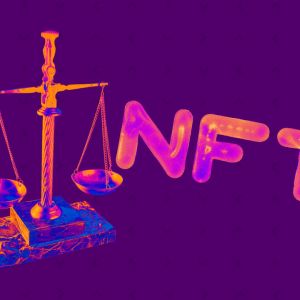Ethereum, the world’s second-largest blockchain, is facing increasing scrutiny and debate over its long-term direction. On one side, co-founder Vitalik Buterin has proposed a fundamental redesign of Ethereum’s execution layer, suggesting a shift to the RISC-V instruction set architecture to address performance and scalability issues. On the other hand, seasoned trader Peter Brandt has cast doubt on Ethereum’s near-term prospects, pointing to bearish technical signals and forecasting a possible price drop to $800. As the community weighs ambitious technical reforms against declining market sentiment, Ethereum's future appears more contested than ever. Vitalik Buterin Proposes Radical Shift to RISC-V for Ethereum, Aiming to Revive Network Efficiency and Investor Confidence Ethereum co-founder Vitalik Buterin has ignited fresh debate in the blockchain development community with a bold proposal to overhaul the Ethereum Virtual Machine (EVM), the foundational execution engine for Ethereum smart contracts. In an April 20 post, Buterin suggested replacing the EVM’s current bytecode system with RISC-V, a streamlined open-source instruction set architecture (ISA), in a move he claims could boost Ethereum’s execution-layer efficiency by up to 100-fold. The proposal, which follows months of scrutiny over Ethereum’s declining fee revenue and user base, targets a number of long-standing bottlenecks in the network’s scalability and competitiveness. Among these are stable data availability sampling, block production competitiveness, and efficient zero-knowledge proof generation — all crucial to Ethereum’s long-term survival in a rapidly evolving blockchain landscape. “The beam chain effort holds great promise for greatly simplifying the consensus layer of Ethereum,” Buterin wrote. “But for the execution layer to see similar gains, this kind of radical change may be the only viable path.” RISC-V: A Path to Execution-Layer Reinvention The RISC-V instruction set has gained popularity in recent years due to its flexibility, performance benefits, and open-source licensing. Originally developed for educational and industrial use in hardware architecture, its application in blockchain smart contract environments is unprecedented — and potentially revolutionary. Buterin’s argument centers on the idea that Ethereum’s aging EVM is a significant constraint on performance, particularly in the context of emerging blockchain systems like Solana and Sui that use more efficient virtual machine designs. Ethereum’s modular approach — splitting responsibilities between the base layer and layer-2 rollups — has allowed scalability through sidechains and rollups, but has left the core execution engine comparatively stagnant. Switching to RISC-V, Buterin claims, would enable Ethereum to natively support more complex and faster zero-knowledge (ZK) operations, crucial for secure, scalable, and private computation. Buterin’s proposal comes as Ethereum continues to face mounting pressure from faster, monolithic chains. Solana and Sui have both made headlines in recent months for their high transaction throughput and low-cost user experience, backed by aggressive developer incentives and increasing dApp activity. Meanwhile, Ethereum’s base layer has experienced a troubling drop in revenue. Blob fees — transaction fees associated with data from Ethereum’s rollup-centric design — fell to a weekly low of just 3.18 ETH in late March 2025, worth approximately $5,000 at the time. According to data from Etherscan and Token Terminal, the average network fee per transaction also plunged to just $0.16 in April, a level not seen since 2020. Brian Quinlivan, Director of Marketing at Santiment, attributed the falloff to declining user activity on the base layer, as more users and developers gravitate toward layer-2 solutions. Ethereum network weekly transaction fees declined significantly in Q1 2025 (Source: Token Terminal ) A Double-Edged Sword: Layer-2 Cannibalization While layer-2 solutions like Arbitrum, Optimism, and Base have greatly improved scalability and cost for end users, they’ve also been accused of cannibalizing the Ethereum mainnet’s usage and revenue. These solutions collect fees off-chain or on separate execution environments, leading to a dramatic shift in where value is captured within the Ethereum ecosystem. The resulting financial pressure has contributed to Ether’s recent price woes. As of mid-April 2025, ETH is trading at around $1,637 — a far cry from its 2021 and 2022 highs. Some analysts warn the price could dip further to as low as $1,100 if investor sentiment continues to deteriorate in the face of weak fundamentals and aggressive competition. Buterin’s vision of a RISC-V-powered execution layer appears to be a direct response to this existential threat. By rejuvenating Ethereum’s technical core, the network may be able to reclaim its leadership status not only as a smart contract pioneer but as a sustainable and high-performance blockchain infrastructure. Buterin's latest move is not without controversy. Critics argue that such a sweeping change could fracture developer tooling and create additional friction in onboarding new developers. Others question whether RISC-V, traditionally associated with hardware, is the right fit for smart contract execution. Still, supporters say Ethereum needs bold action to survive what some are calling the ”great blockchain divergence” — a period where high-performance chains peel away market share from older, slower networks. If implemented, this proposal could mark one of the most transformative moments in Ethereum’s history since its launch. Whether Ethereum’s developer community and ecosystem stakeholders embrace this radical redesign remains to be seen — but one thing is clear: the future of Ethereum may very well depend on its willingness to evolve from within. Peter Brandt Predicts Ethereum Crash to $800 as ETH Battles Bearish Technicals and Sentiment Divide Veteran trader Peter L. Brandt, a commodities expert with nearly five decades of market experience, has rattled the Ethereum community with a grim technical forecast. In a recent tweet that included a stark descending triangle chart pattern, Brandt predicted that Ethereum (ETH) could collapse to as low as $800 — revisiting its 2022 bear market bottom. Brandt’s latest post comes amid a period of heightened uncertainty for the world’s second-largest cryptocurrency. ETH has already endured a 46% decline over the past year and fell 4% on Wednesday following the Federal Reserve's decision to keep interest rates steady. Though it has recovered slightly, Brandt’s chart positions ETH dangerously close to a prolonged breakdown. The descending triangle pattern, which Brandt emphasized in his chart, is a classic bearish technical formation that usually suggests a continuation of a downtrend. The market veteran is known for his unforgiving takes on digital assets, and earlier this week, he went so far as to call Ethereum “worthless junk” — a statement that sparked fierce debate among crypto traders and Ethereum supporters. A Divided Market: Ethereum Bears vs Bulls While Brandt's prediction reflects a broader sentiment of disillusionment around Ethereum’s recent performance, not everyone is on the same page. In a twist of sentiment polarization, celebrity endorsements and crypto moguls have voiced optimism for ETH. NBA legend and crypto enthusiast Scottie Pippen publicly predicted the dawn of a major altcoin season, rooted in historical Bitcoin cycle patterns. According to Pippen, altcoin rallies tend to ignite roughly 340 days after each Bitcoin halving event. The most recent halving occurred on April 20 of last year — a timing coincidence that has fueled speculation in crypto circles. Scottie Pippen stated that he was bullish on ETH long-term since he is building a project on this network. It is focused on AI, gaming and tokenization of real-world assets (RWA). Echoing Pippen’s sentiment, Tron founder Justin Sun has reaffirmed his support for Ethereum. Despite the lackluster price action and a growing chorus of critics, Sun announced that Tron has no intention of selling its ETH holdings. Instead, he emphasized future collaboration with Ethereum developers, signaling a desire for a more cooperative and integrated crypto ecosystem. Ethereum's struggle is not just technical — it's systemic. The broader macroeconomic environment, tepid institutional demand for ETH-based ETFs, and Ethereum’s own scaling challenges have conspired to drive down sentiment. When Brandt posted his chart, Ethereum was trading at $1,587 — near the lower boundary of its recent trading range. The 4% dip after the Fed announcement reflects investors’ increasing sensitivity to macroeconomic signals, particularly interest rates that affect the appeal of risk-on assets like cryptocurrencies. Meanwhile, ETH-based spot ETFs, approved alongside Bitcoin ETFs last year, have not garnered the same capital inflows. Data shows that Bitcoin ETFs have consistently outperformed their Ethereum counterparts in terms of net inflows and investor demand. This divergence has placed added pressure on ETH, especially as questions linger about its monetization model, base-layer revenue decline due to Layer-2 migration, and relatively slower development pace compared to rising Layer-1 competitors like Solana and Sui. The $800 Scenario: A Realistic Risk or an Outlier? Brandt's $800 forecast would mark a staggering drop of nearly 50% from current levels — a move that would likely shake investor confidence and create ripple effects across decentralized finance (DeFi), NFTs, and Web3 projects built on the Ethereum network. Yet even some Ethereum skeptics question the likelihood of such a deep retracement. The network remains the most widely used smart contract platform, with significant developer activity, institutional interest, and long-term infrastructure playbooks backing its future. Still, history has shown that when Brandt speaks, markets tend to listen — if not react.


















